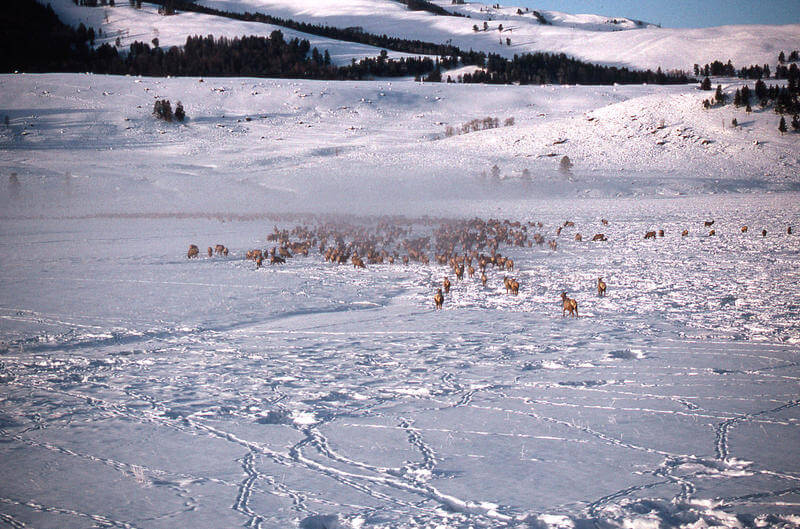When Wildlife Remain Elusive, Follow The Clues
by Jennifer Dolese
Broadcast 11.20 & 11.25.2016 and 11.3 & 11.6.2020

Elk herd in Lamar Valley: Jim Peaco, NPS (public domain)
Listen:
A couple of weekends ago, some friends and I got up early to drive into the Flint Creek Range near Anaconda. We planned to hike through an area that we’d been told was home to some 800 elk, 150 big horn sheep, 30 mountain goats, black bear, and moose. We walked up the trail with great anticipation for a day of spectacular wildlife viewing.
The sky was slate-gray, and it wasn’t long before we encountered our first snowflakes and felt our hands getting numb. We looked for big animal bodies somewhere off in the Douglas-fir and lodgepole pine, or on the high cliffs that bordered the valley, but we saw only red squirrels and a few birds. Finally, a meadow came into view. Surely this would be the spot to see some elk! We quietly stepped out of the trees and into the open.
Nothing. Who was it anyway that said there was a big herd of elk in this valley?
But wait. If you aren’t able to see the animal itself – which is often the case – what’s almost as special is finding a sign of the animal you are looking for. And this meadow was chock-full of elk sign.
Back on the trail, we had seen the large, rounded prints of an elk track. We could tell that this had been an elk at walk because of the pattern of the hind track covering and partly obliterating the front. Now, in the meadow, we saw lots of tracks punched into the soft grassy earth. Along with the myriad tracks were piles of scat, the pellets individually formed – indicating that the animals were feeding more on browse and dry grasses and were not eating as much moist vegetation as in summertime, when succulent vegetation causes pellets to lose their shape and look more like cow patties.
We saw that the young shoots of nearby willow branches were splintered and broken, indicating that the elk were browsing here for food. And some of the small saplings in the woods had scrape marks, a sign that the bulls had been rubbing velvet from their antlers, which begins to fall off in August or September.
With the snow falling, the wind blowing, and temperatures dropping into the twenties, it could have meant that the elk that had clearly been using this meadow had now moved back into the trees for shelter. Or maybe they had heard our not-so-quiet talking through the trees and had thought it best to sneak off in the opposite direction.
We were disappointed that we didn’t see any big animals, but wild animals are elusive. What isn’t elusive are the tracks and signs they leave behind, telling their story. Nature is like a storybook, and the more one pauses to learn how to read the clues in its chapters, the richer and more intimate the story will be.
Every week since 1991, Field Notes has inquired about Montana’s natural history. Field Notes are written by naturalists, students, and listeners about the puzzle-tree bark, eagle talons, woolly aphids, and giant puffballs of Western, Central and Southwestern Montana and aired weekly on Montana Public Radio.
Click here to read and listen to more Field Notes. Field Notes is available as a podcast! Subscribe on iTunes, Google Play, or wherever you listen to podcasts.
Interested in writing a Field Note? Contact Allison De Jong, Field Notes editor, at adejong [at] montananaturalist [dot] org or 406.327.0405.
Want to learn more about our programs as well as fun natural history facts and seasonal phenology? Sign up for our e-newsletter! You can also become a member and get discounts on our programs as well as free reciprocal admission to 300+ science centers in North America!












